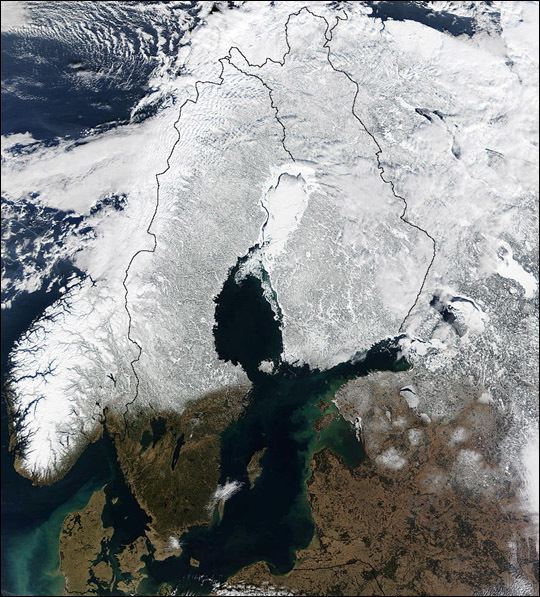 | ||
The Hilleviones were a Germanic people occupying an island called Scatinavia in the 1st century AD, according to the Roman geographer Pliny the Elder in Naturalis Historia (Book 4, Chapter 96), written circa 77 AD. Pliny's Scatinavia is generally believed to have referred to the Scandinavian peninsula, which in the 1st century AD had not yet been fully explored by the Romans and was therefore described as an island. Pliny wrote that it was an island "of a magnitude as yet unascertained". The Hilleviones lived in the only part of the island that was known, and according to Pliny, they thought of their 500 villages as a separate (alterum) world.
Contents
Pliny's description
Along the route to Scatinavia, as described by Pliny, were unexplored islands with people who were rumoured to have "ears of such extraordinary size as to cover the rest of the body, which is otherwise left naked". On neighboring islands, "human beings are produced with the feet of horses", Pliny wrote. Leaving these unfamiliar lands behind, a traveller will enter the nation of the Ingaevones in Germania, where, according to Pliny, "we begin to have some information upon which more implicit reliance can be placed". In this more familiar territory is a mountain range called Saevo, which stretches all the way to a large promontory called Cimbri (Cimbrorum), which ends in a gulf called Codanus. It is here, in this gulf, that the island of Scatinavia can be found.
The section that mentions the Hilleviones is short:
"Incipit deinde clarior aperiri fama ab gente Inguaeonum, quae est prima in Germania. mons Saevo ibi, inmensus ad Cimbrorum usque promunturium efficit sinum, qui Codanus vocatur, refertus insulis, quarum clarissima est Scatinavia, inconpertae magnitudinis, portionem tantum eius, quod notum sit, Hillevionum gente quingentis incolente pagis: quare alterum orbem terrarum eam appellant. nec minor est opinione Aeningia."(Leaving these, we come to the nation of the Ingævones, the first in Germany. In their country is an immense mountain called Sevo, not less than those of the Riphæan range, and which forms an immense gulf along the shore as far as the Promontory of the Cimbri. This gulf, which has the name of the 'Codanian,' is filled with islands; the most famous among which is Scandinavia, of a magnitude as yet unascertained: the only portion of it at all known is inhabited by the nation of the Hilleviones, who dwell in 500 villages, and call it a second world: it is generally supposed that the island of Eningia is of not less magnitude.)In another chapter of Naturalis Historia, Pliny mentions an island called Tyle (Book 4, Chapter 104)
Interpretations of the name
Since the name Hilleviones only appear in Pliny, several attempts have been made to connect the name with different tribes mentioned in other classical texts and with different ethnic groups of the modern era. A solution offered by some late 19th century and early 20th century scholars is that Hilleviones is a corruption of the phrase ille and (S)uiones, but this approach requires an alteration of the original text. (Similar references to "textual errors" or "corruption of the archetype manuscript" were also used by early 20th century scholars in order to equate Ptolemy's Leuonoi with the Suiones mentioned by Tacitus.)
Another idea is that the Hilleviones were an early population of Halland in Sweden. This idea is based on discussions about a common root in the two names and suggestions that the tribe name has been preserved in the name of the province. If so, the Hilleviones could be the same as the Hallin, of Scandza, who are mentioned by Jordanes. Hilleviones could be segmented Hill-eviones, where the -eviones would have the same etymology as for the Auiones. The Hil- or Hal- therefore would represent the name of the people. Other scholars have suggested a possible connection to the Helveconae of the southern Baltic coast.
Finding ways to equate Pliny's Hilleviones, Tacitus' Suiones and Jordanes' Suehans was a goal pursued with special vigor in the 17th century by the Rudbeckians of the Swedish Hyperborean School, who hoped to show that Sweden was not only the home of the original Goths, but also the "womb of mankind". In the center of this movement was Uppsala professor and poly-scientist Olaus Rudbeck (1630–1702), whose work is described by Flemming Lundgreen-Nielsen, professor, Department of Scandinavian Studies and Linguistics, University of Copenhagen as follows: "By means of fantastical etymologies and bold combinations of historical and scientific facts, Olaus Rudbeck showed that Sweden was the cradle of mankind and all early civilization, identifiable with Plato's lost continent of Atlantis. He considered the Swedish language to be the mother of all other tongues and saw Greek and Roman mythology as distorted versions of now-lost Swedish proto-myths." The efforts to construct a long, glorious history for Sweden became a political aim at the time of the Thirty Years War and culminated with the era of Swedish expansionism.
